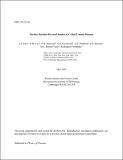| dc.contributor.author | Rice, John E. | en_US |
| dc.contributor.author | Cao, N.M. | en_US |
| dc.contributor.author | Diamond, P.H. | en_US |
| dc.contributor.author | Greenwald, M.J. | en_US |
| dc.contributor.author | Hubbard, Amanda E. | en_US |
| dc.contributor.author | Marmar, E.S. | en_US |
| dc.contributor.author | Reinke, M.L. | en_US |
| dc.contributor.author | Rodriguez-Fernandez, P. | en_US |
| dc.date.accessioned | 2025-03-21T20:23:23Z | |
| dc.date.available | 2025-03-21T20:23:23Z | |
| dc.date.issued | 2023-05 | |
| dc.identifier | 23ja036 | |
| dc.identifier.uri | https://hdl.handle.net/1721.1/158738 | |
| dc.description | Submitted for publication in Physics of Plasmas | |
| dc.description.abstract | Studies of core toroidal rotation reversal phenomenology in C-Mod deuterium L-mode plasmas have been expanded to include details of the dependences on plasma current and toroidal magnetic field. Rotation reversal occurs at a critical density and universal scaling indicates that the product of n_crit q_95 R ~ B_T/2, with n_crit in 10^20/m^3, R in m and B_T in T. Measurements in H and He plasmas exhibit similar behavior, including a connexion with the LOC/SOC transition and the cut-off for non-diffusive heat transport. Electron density and ICRF power modulation experiments suggest that the collisionality nu_* is a unifying parameter. Strong impurity puffing causes the critical density to increase, indicating that the situation is more complicated than only collisionality, perhaps involving the details of the effects of dilution on ITG mode stability. | |
| dc.publisher | AIP | en_US |
| dc.relation.isversionof | doi.org/10.1063/5.0159632 | |
| dc.source | Plasma Science and Fusion Center | en_US |
| dc.title | Further Rotation Reversal Studies in C-Mod L-mode Plasmas | en_US |
| dc.type | Article | en_US |
| dc.contributor.department | Massachusetts Institute of Technology. Plasma Science and Fusion Center | |
| dc.relation.journal | Physics of Plasmas | |
